A Complete Guide to Birthstone Jewelry
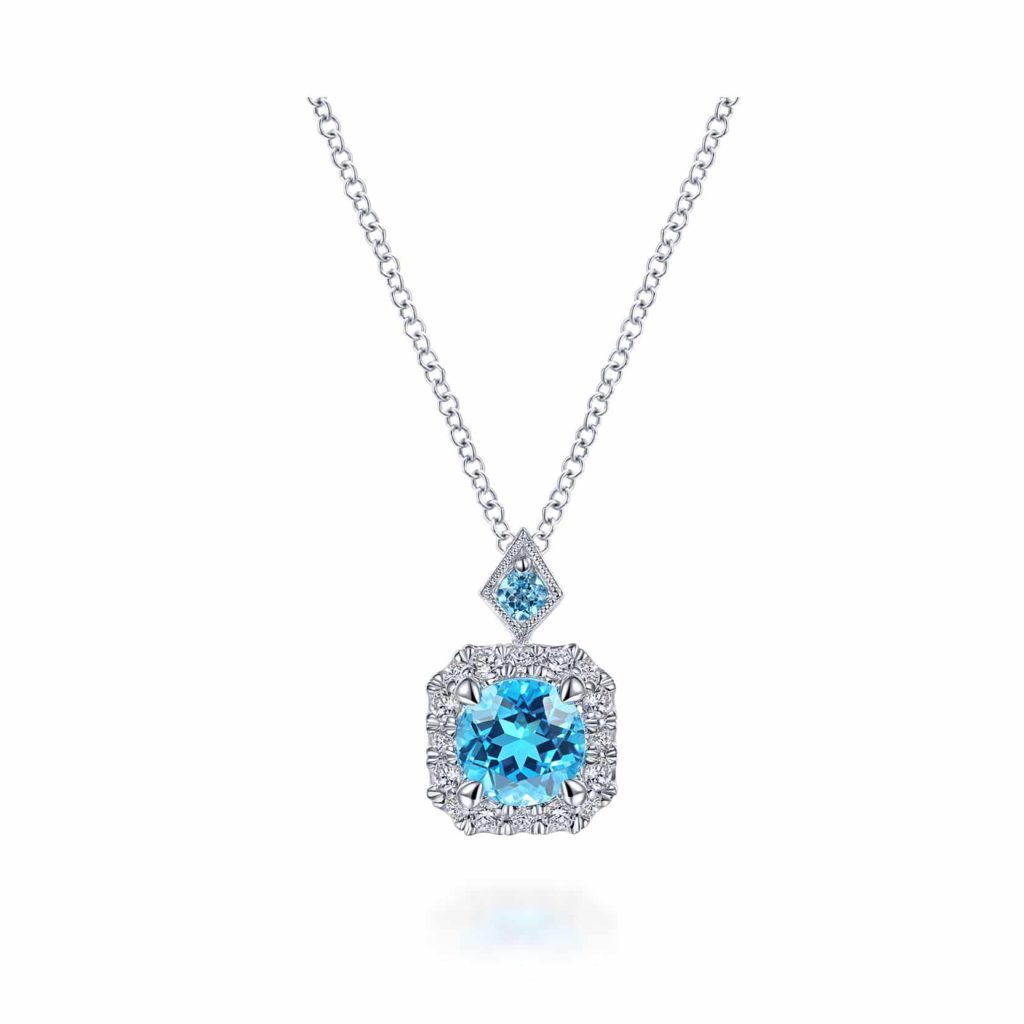
Birthstones have been around since ancient times. They first originated as the twelve gems representing the twelve tribes of Israel on Aaron’s breastplate. Although birthstones started with religious origins, first-century scholars began to associate the twelve gemstones with zodiac signs, and later each stone was given a unique month to represent. In 1912, the National Association of Jewelers officially defined the list of birthstones. Birthstones are unique to each month, and therefore each individual lucky enough to be born in that month. Find your birthstone below to see what makes you special, as well as the unique facts surrounding your birthstone!
- January – Garnet
- February- Amethyst
- March- Aquamarine
- April- Diamond
- May- Emerald
- June- Alexandrite
- July- Ruby
- August- Peridot
- September-Sapphire
- October-Opal
- November-Citrine
- December-Zircon
January: Garnet
“Those with this birthstone can be described by the very same characteristics of garnet. They are passionate, bold, and carry themselves with confidence.”
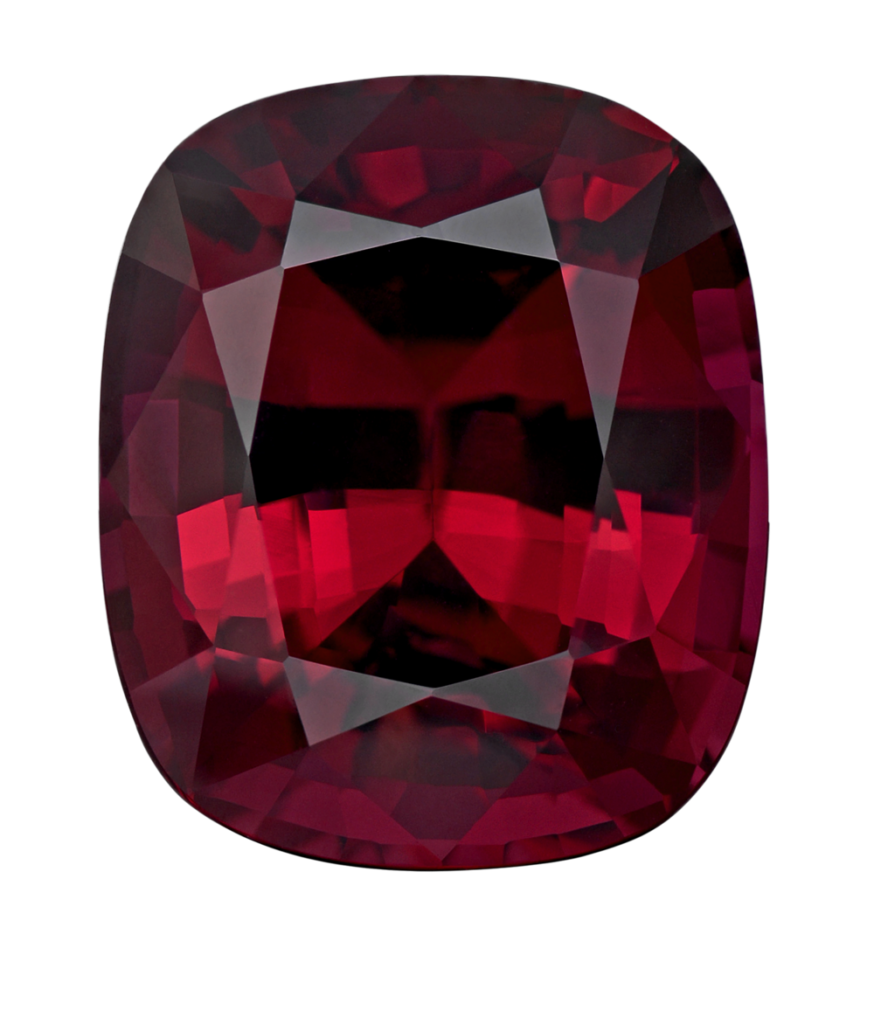
History and Origin
The history of garnet in jewelry can be traced all the way from the Egyptians to ancient Greek and Roman empires. The name ‘garnet’ comes from the Latin word ‘garanatus’ meaning seedlike, in reference to a pomegranate. In Greek mythology, a pomegranate is a gift of love and eternity, it is often used as a gift for a second anniversary. Thousands of years ago, red garnet necklaces adorned the necks of Egypt’s pharaohs, and were entombed with their mummified corpses as prized possessions for the afterlife.
Color and Cut
Garnet is actually the name for a group of minerals with common crystal structures, but slightly different chemical compositions, resulting in gemstones in almost every color. Red garnets are the most widely known, but gemstone buyers and collectors can pick from a rainbow of garnet colors: greens, oranges, pinkish oranges, purplish reds and even some blues.
Myth and Personality
Back in medieval times, garnets were thought to cure depression and protect against bad dreams. Many believe that garnets will help a wound heal and offers other benefits relating to the bloodstream. Garnet’s virtues have been long believed to include passion, true friendship, success, self-esteem, energy, and truth
February: Amethyst
“Amethyst contains many qualities and those born in February can inherit the same. They are intelligent, sincere, and quick-witted.”

History and Origin
Amethyst has been the most sought after quartz variety gemstone for centuries. Since amethyst was as expensive as rubies and emeralds, it was available only to royalty. This changed in the 19th Century when large deposits were discovered in Brazil. Today, because it is plentiful and affordable, amethyst is used in mass-market jewelry and more exceptional stones are found in designer pieces.
Color and Cut
Amethyst’s purple color can range from a light lilac to a deep, intense royal purple, and from brownish to vivid. The finest color is a strong reddish purple to dark purple as long as the stone is not so dark it reduces the brightness. Amethyst is cut into a variety of standard shapes and cutting styles. Amethyst is also a very popular gem for cutting into a variety of freeform shapes. This is done by hand or by automated cutting. These so-called fantasy or designer cuts can be mass produced or created as one-of-a-kind pieces.
Myth and Personality
Because of its wine-like color, early Greek legends associated amethyst with Bacchus, the god of wine. Other legends included beliefs that amethyst kept its wearer clear-headed and quick-witted in battle and in business affairs. Because amethyst was associated with wine, it was believed that wearing amethyst prevented intoxication(amethystos means “not drunk” in ancient Greek.) The virtues of amethyst include beauty, calm, humility, a loving demeanor, sincerity, and wisdom.
March: Aquamarine
“Those born in March can be described with the same characteristics as the aquamarine and are referred to as brilliant, resilient, and enchanting.”

History and Origin
The name “aquamarine” is derived from two Latin words: aqua, meaning “water,” and marina, meaning “of the sea.” Some people referred to aquamarine as “the sailor’s stone.”
Color and Cut
Aquamarine’s color range is very narrow, usually contains blue or greenish blue hues. The gem’s most valuable color is a dark blue to slightly greenish blue with moderately strong intensity. In general, the purer and more intense the blue color, the more valuable the stone. The gemstone’s hardness and transparency make it popular with designers, artists, and carvers.
Myth and Personality
Sailors would take aquamarines on sea journeys and toss them into the ocean as gifts to Poseidon to assure a safe voyage. Legend has it that Poseidon would give the aquamarines to mermaids as gifts. Aquamarine was also believed to make the wearer unconquerable and amiable and quicken the intellect.
April: Diamond
If you have an April birthday, you inherit traits just like the diamond. Both are calming, unique, and one-of-a-kind.”

History and Origin
Diamonds have a long history as beautiful objects of desire. In the first century AD, the Roman naturalist Pliny stated: “Diamond is the most valuable, not only of precious stones, but of all things in this world.” It is believed that diamonds were first found in the rivers and streams of India. Some historians estimate that India was trading in diamonds as early as the fourth century BC.
Color and Cut
The color of a diamond can range from crystal clear to a light tinted yellow. The cut of a diamond can either help or hurt the value of the gem by accentuating the natural inclusions and shape of the diamond. The cut is specific to the symmetry and polish of the diamond, meaning that a better cut will better illuminate the diamond.
Myth and Personality
In addition to being a symbol of everlasting love, diamonds were once thought to bring courage. In Sanskrit, the diamond is called vajra, which also means lightning; in Hindu mythology, vajra was the weapon of Indra, the king of gods. The virtues of diamond include resilience, wisdom, good fortune, and calm.
May: Emerald
“Those born in May can be described by the very same characteristics of the emerald. They are soothing, imaginative, and carry themselves stress-free.”

History and Origin
The largest producer of emerald is Columbia in South America. Emeralds from Colombia were part of the plunder when sixteenth-century Spanish explorers invaded the New World. The Incas had already been using emeralds in their jewelry and religious ceremonies for 500 years. The Spanish, who treasured gold and silver far more than gems, traded emeralds for precious metals. Their trades opened the eyes of European and Asian royalty to emerald’s majesty. Its color reflects new spring growth, which makes it the perfect choice of a birthstone for the month of May.
Color and Cut
The radiance of its color makes the emerald a very unique gemstone. However, emerald almost always has some inclusions. These fissures, small crystal, and even bubbles often mar the evenness of the gemstone’s color. Fine inclusions do not diminish the high regard in which it is held. In fact, even with inclusions, an emerald in a deep, lively green still has a much higher value than an almost flawless emerald which is paler in color. Emerald is always green and the most famous member of the beryl family, which also includes aquamarine, Morganite, and other lesser-known gemstones. The green in emeralds is caused by the presence of chromium or vanadium.
Myth and Personality
It is believed that emerald’s lush green has soothed souls and excited imaginations since antiquity. The name comes from the ancient Greek word for green, “smaragdus.” In Natural History, published in the first century AD, Rome’s Pliny the Elder described emerald as “…nothing greens greener.” He described the use of emerald by early lapidaries, who “have no better method of restoring their eyes than by looking at the emerald, its soft, green color comforting and removing their weariness and lassitude.” Even today, the color green is known to relieve stress and eye strain.
June: Alexandrite
“Those born in June express similar traits like Alexandrite. They are purposeful, strong, and light-hearted.”
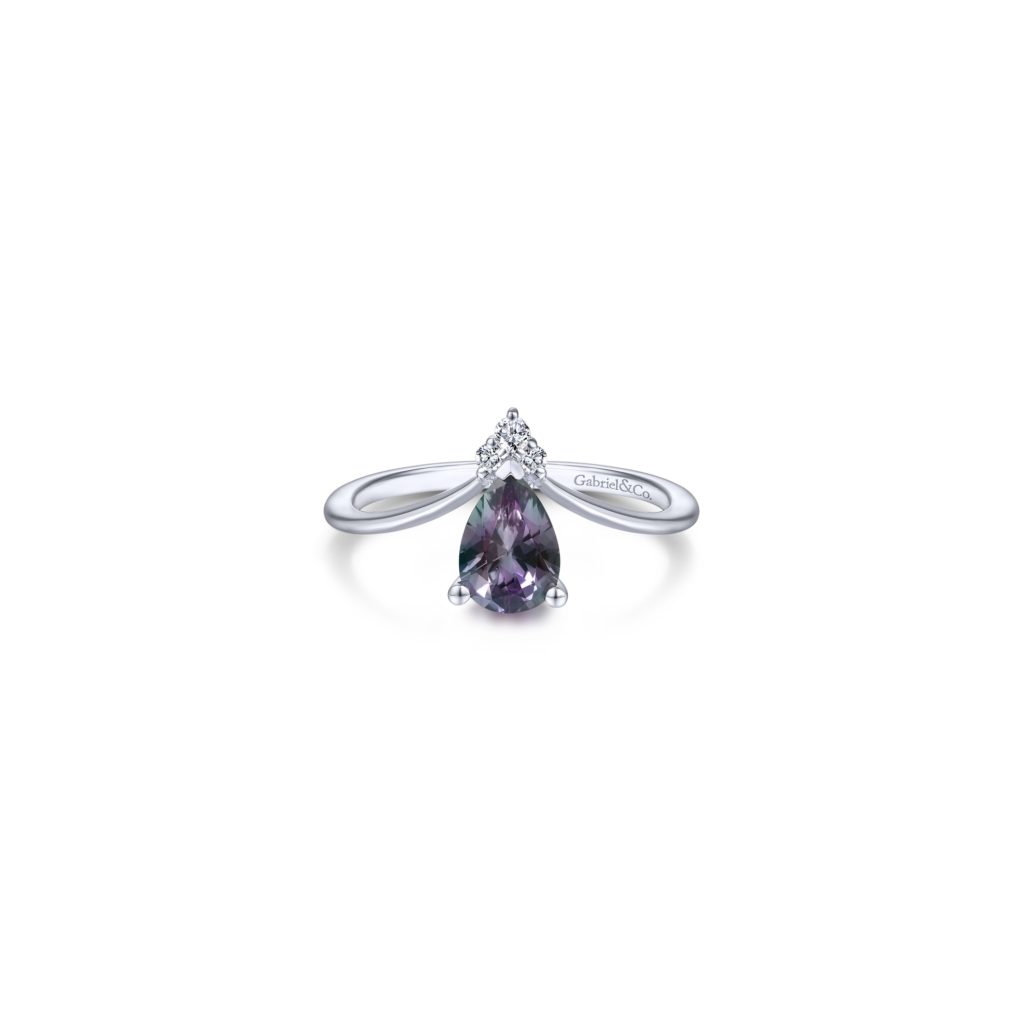
History and Origin
It is said that, in the 1830s, mineralogist Nils Gustaf Nordenskiold discovered alexandrite in the Ural Mountains of Russia on the sixteenth birthday of Alexander II. He named the stone in honor of the future Czar Alexander II of Russia. While this is a popular story of the discovery of Alexandrite, it is controversial to some and only adds to the mystique of this rare gem.
Color and Cut
An ideal alexandrite is a stone with medium tone and intense colors that change from blue green in daylight to ruby red or purplish-red under incandescent light or candlelight. Some alexandrites are considered less valuable because the colors bleed, meaning that both colors can be seen at the same time. Since the light sources are often mixed anyway, this occurrence is actually very common. Brownish and grayish tones are very common in alexandrites, and their presence makes the stones less attractive and less valuable.
Myth and Personality
It is also said that the stone reminds us of our purpose in life and our origin. It gives hope to those who are in despair about their lives. It brings strength and constantly reminds them of the light. With its changing color, it is a reminder that life is not only what it seems to be.
July: Ruby
“Ruby is a bold gemstone and those born during July carry much of the same qualities. They are passionate, wise, and carry themselves with a full heart.”
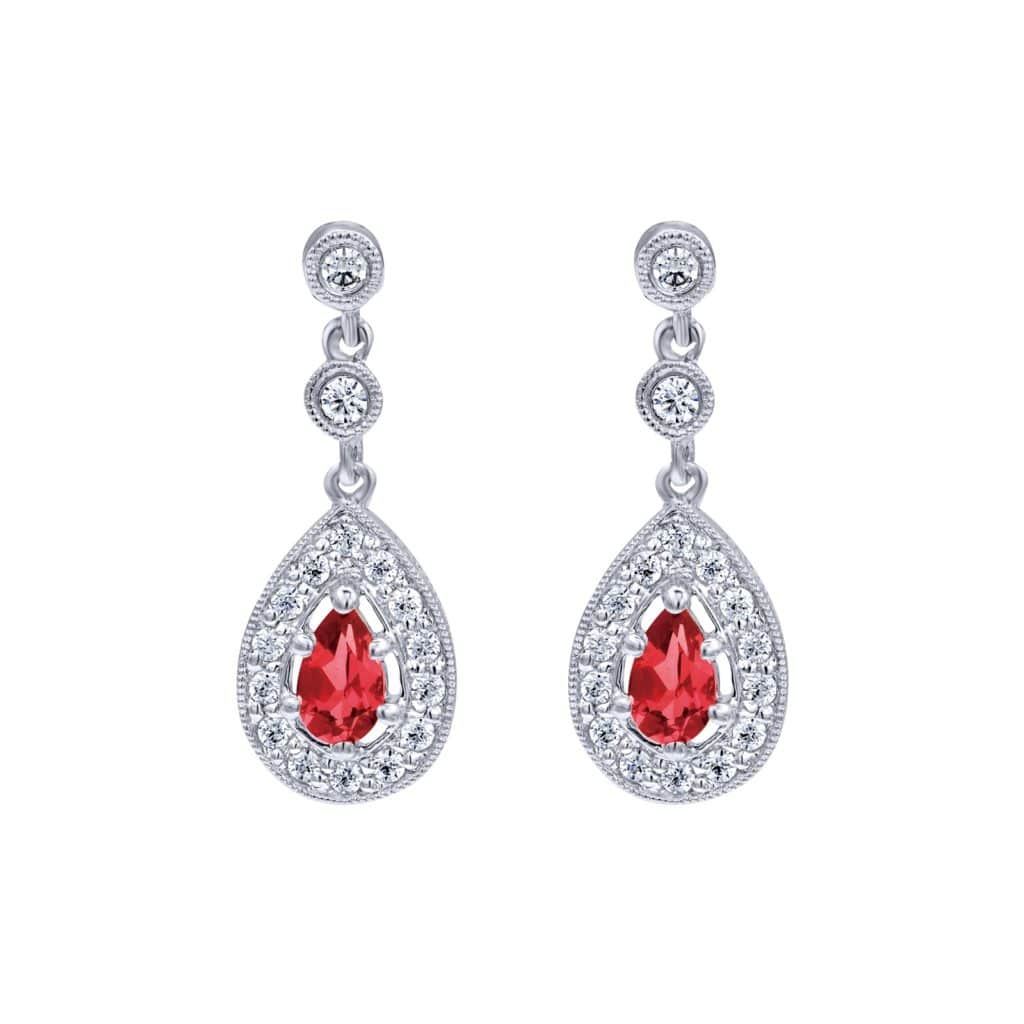
History and Origin
Historically, ruby is one of the most significant colored stones. There are four mentions of ruby in the Bible, and some of these mentions associate the gemstone with attributes like beauty and wisdom. In the ancient language of Sanskrit, ruby is called ratnaraj, or “king of precious stones.”
The name ruby comes from the Latin word ruber, which means “red.” The glowing red of ruby suggests an inextinguishable flame burns in the stone that could shine through clothing and seems intense enough to be able to boil water.
Color and Cut
Ruby is a variety of the corundum mineral species that also includes sapphire. Ruby is the most valuable variety of corundum and can in fact command the highest per-carat price of ANY colored stone, a power that makes it one of the most important gems in the colored stone market. The mineral corundum is colorless in its purest form, but trace elements of chromium cause the ruby’s red color, which can range from an orangy-red to a purplish red. The amount of chromium present directly affects the strength of the ruby’s red color: the more chromium, deeper the hue of red. The level of intensity can also be increased when the chromium causes fluorescence.
Myth and Personality
Ruby’s intense red color often mirrors some of our most intense emotions, such as love and anger, passion and fury. Early cultures treasured rubies for their similarity to the redness of the blood that flowed through human veins, and some of these humans believed that rubies held the power of life. It has been said that the owner of a fine ruby is assured three things: having a good life, living at peace with all men, and never having his rank or land be taken from him. It was also thought that the wearer of a ruby would be blessed with health, wealth, wisdom, and outstanding affairs of the heart.
August: Peridot
“Those with this birthstone can be described by the very same characteristics of peridot. People born in August are friendly, content, and seek to spread happiness.”

History and Origin
The origins of the name of this gorgeous green-tinted August birthstone are unconfirmed. The word peridot (PEAR-ih-doe) either comes from the French word “peritot” meaning “unclear” or the Arabic word “faridat,” which means, “gem.” However, while the source of the name is a mystery, the sources of actual peridot are far-reaching. Peridot is found as nodules in some lava flows and, very rarely, in solidified molten rock in pockets or veins lined with peridot crystals. While the volcanoes on the islands of Hawaii have produced some peridots large enough to be fashioned into gemstones, the island of Oahu has a beach formed from tiny grains of peridot.
Color and Cut
Peridot is one of the few gemstones that come in only one color: green. The color ranges from olive to yellow green. The most prized peridots contain a lot of iron and have a deep green hue with no hint of brown or yellow. These higher-quality stones tend to weigh in excess of ten carats and usually come from Myanmar and Pakistan. In today’s marketplace, almost all of the peridot gemstones offered are a more yellowish green. Since rough peridot is readily available, the stone can be fashioned into many different shapes and cutting styles. In addition to the jewelry industry’s standard gem shapes, designers contribute to a myriad of other variations of the standard cuts and create mixed cuts as well as beads and carvings.
Myth and Personality
Peridot has long been considered to be an aid to friendship and supposedly frees the mind of envious thoughts. It is also supposed to protect the wearer from the evil eye. Other legends credit peridot with bringing happiness and good cheer, attracting lovers, and strengthening the eyes.
September: Sapphire
“Those with this birthstone can be described by the very same characteristics of sapphire. They are innocent, peaceful, and full of serenity.”

History and Origin
The name “sapphire” comes from the Latin saphirus and the Greek sapheiros, which both mean “blue”. Sapphires have been a very sought-after and prized gemstone since 800 BC, and folklore surrounding sapphire is wide-ranging. The ancient Persians once believed that the Earth rested on a giant sapphire and that its reflection colored the sky blue.
Historically, sapphires have been worn as a talisman for protection against diseases and for peace and happiness. The kings and queens of ancient Greece and Rome believed that owners of blue sapphires were protected from envy and harm. Sapphire has been the chosen gemstone for centuries to adorn the robes of clergy and royalty because it symbolizes truth, sincerity, nobility, and faithfulness.
Color and Cut
Sapphire is one of our favorite gemstones at Brittany’s Fine Jewelry for many reasons. Sapphire is hard (resists scratching) and tough (resists fractures), so it is the perfect gemstone choice for jewelry that you want to wear often. Sapphire is a member of the corundum family, and even though most people think of blue when they hear the word sapphire, the gemstone comes in every color. “Fancy sapphire” is a term given to all sapphires that are not blue, except for the red ones, because they are commonly known as ruby.
Fancy sapphires can be found in pink, purple, violet, green, yellow, orange, and intermediate hues. Some crystals have been mined that contain two or more colors and, once cut, have yielded a “parti-colored” gemstone. Color change sapphires have been discovered as well as those exhibiting asterism, also known as the star effect.
Myth and Personality
The sapphire has, for centuries, been seen as a symbol of the heavens, a guardian of innocence. It is believed to bring gifts of fulfillment, joy, prosperity, inner peace and beauty. It helps find peace of mind and serenity and promotes a life of sincerity, helping preserve one’s innocence while learning life’s truths.
October: Opal
“Those born in October can see similar traits from opal in themselves. They are lucky, full of wonder, and versatile.”

History and Origin
The name opal is thought to be derived from the Sanskrit upala, meaning “precious stone,” and later the Greek derivative “Opallios,” meaning “to see a change of color.”
Color and Cut
Opal, more than any other gemstone, exhibits a wide variety of appearances and color choices. It is such a unique stone that an opal can have a noticeably different look from every angle. Opal dazzles the eye with a spectacular display of flashing and dancing colors – colors that move and shift within the stone’s many layers. There have been many terms used to describe opal, from “fireworks” to “rainbows”.
Examining an opal under a powerful microscope reveals the secret behind its unique display of all the colors of the rainbow, which is called play-of-color. Opal achieves play-of-color due to the fact that opal is made up of countless sub-microscopic spheres stacked tightly together. The spheres range in size from 0.1 micron (one ten-millionth of a meter) to 0.2 microns in size. The size of the sphere dictates the color of it. A 0.1-micron sphere is violet, while a 0.2-micron sphere is red, and all of the sizes in between make up the many other colors seen in opal. When light travels between the spheres, the waves bend and break up into the many spectral colors displayed in a fine opal.
Myth and Personality
Over time, a myth has spread that it is bad luck to wear opal if it is not your birthstone. While there is no doubt that many opals have been damaged or broken, such situations usually result from improper care rather than bad luck. In reality, the origin of this notion actually comes from a book written in the 1800s by Sir Walter Scott entitled Anne of Geierstein. Therefore, unless you truly believe the myth of the book, there is no need to believe that opals bring bad luck. In fact, at Brittany’s Fine Jewelry, we always feel very lucky to behold all of the wonder and luster of opal.
November: Citrine
Those born in November are very similar to their birthstone, citrine. They are the ones to light up the room when they walk in, bringing in positive energy”

History and Origin
Citrine is composed of one of the most abundant minerals on Earth: quartz. The abundance of quartz would lead one to believe that citrine would be easily found and readily available, but the fact is this gemstone is very rare in nature. Most citrine that is found in jewelry today is actually amethyst, another form of quartz, that has been heat-treated to change its color from light purple to the yellow and orange hues of citrine.
Color and Cut
The color of citrine ranges from light yellow to golden to reddish brown. The reddish brown citrines are commonly referred to as Madeira Citrine because the color closely resembles that of Madeira wine. In Bolivia, amethyst and citrine colors can occur together in the same quartz crystal, and these unique gems are called ametrine.
Since citrine is quartz, the crystals that are heat-treated to become citrine come in many shapes and sizes. Larger gemstones reaching up to twenty carats in size are plentiful, and the price per carat of citrine does not escalate dramatically with these larger sizes. The heat treatment is undetectable and permanent. Therefore, the profusion and reasonable pricing of heat-treated citrine allows designers and gemstone cutters to exercise their creative license and supply unique shapes and facet patterns.
Myth and Personality
Egyptians believed that the sun god Ra cast citrine’s golden color, and jewelry containing citrine has been found from as far back in history as the Hellenistic period. Because of its sunny brightness, citrine is considered the most powerful of all healing stones, and according to history, citrines were carried to ward off evil thoughts and safeguard against snake venom.
December: Zircon
“Those with December birthdays can be described by the very same characteristics of amethyst. Like zircon, they are prosperous, charming, and gentle.”
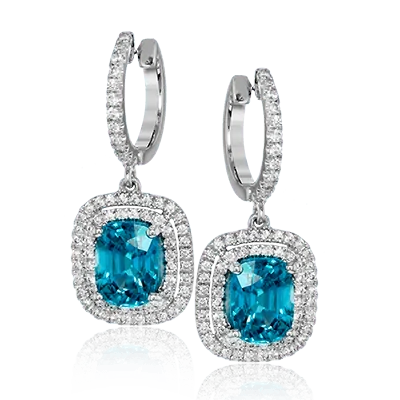
History and Origin
In the early 1900s, colorless, or white, Zircon was widely used as a diamond simulant before more convincing lookalikes took its place. Unfortunately, this might have led to many people confusing zircon with the man-made diamond simulant, Cubic Zirconia. However, modern day it has made its own distinction as a beautifully colored stone with its own share of folklore and charm. Additionally, zircon found in Australia is believed to be 4.4 billion years old, making it the oldest mineral on earth.
Color and Cut
Zircon processes the optical properties of having a high refractive index. It is also doubly refractive: an optical phenomenon exhibited on certain minerals when a single light ray enters the gemstone and then splits into two separate rays. These two properties allow the stone to return a lot of multicolored light called “fire” and unique brilliance to the beholder, which makes it a very popular stone. In fact, the way zircon handles light is so close to that of a diamond, there was much confusion between the two gemstones for centuries.
Zircons are most often cut in oval or round stones allowing their optical properties to bring out fire to its fullest capacity. The cutter must be very careful when working with zircon and pay close attention to the proper angles. Zircons that are not faceted properly will appear blurry due to the strong double refraction.
Myth and Personality
Some scholars believe the name comes from the word zarkun, an Arabic word signifying a reddish hue, but others say it comes from a Persian word meaning “gold colored.” Since zircon presents in a range of colors, this difference seems understandable. In the Middle Ages, the stone was credited for everything from increasing restful sleep to warding off evil spirits to bringing prosperity and honor to its owner.

